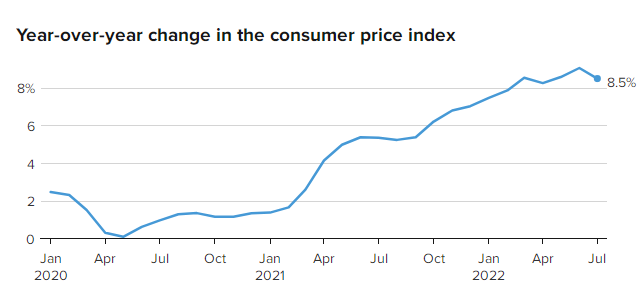Prices that consumers pay for a variety of goods and services rose 8.5% in July from a year ago, a slowing pace from the previous month due largely to a drop in gasoline prices.
On a monthly basis, prices were flat as energy prices broadly declined 4.6% and gasoline fell 7.7%. That offset a 1.1% monthly gain in food prices and a 0.5% increase in shelter costs.
Economists surveyed by Dow Jones were expecting headline CPI to increase 8.7% on an annual basis and 0.2% monthly.
Excluding volatile food and energy prices, so-called core CPI rose 5.9% annually and 0.3% monthly, compared to respective estimates of 6.1% and 0.5%.
Even with the lower-than-expected numbers, inflation pressures remained strong.
The jump in the food index put the 12-month increase to 10.9%, the fastest pace since May 1979. Even with the monthly drop in the energy index, electricity prices rose 1.6% and were up 15.2% from a year ago. The energy index rose 32.9% from a year ago.
Used vehicle prices posted a 0.4% monthly decline, while apparel prices also fell, easing 0.1%, and transportation services were off 0.5% as airline fares fell 1.8% for the month and 7.8% from a year ago.
Markets reacted positively to the report, with futures tied to the Dow Jones Industrial Average up more than 400 points and government bond yields down sharply.
Shelter costs, which make up about one-third of the CPI weighting, continued to rise and are up 5.7% from a year ago.
The numbers indicate that inflation pressures are easing somewhat but still remain near their highest levels since the early 1980s.
Clogged supply chains, outsized demand for goods over services, and trillions of dollars in pandemic-related fiscal and monetary stimulus have combined to create an environment of high prices and slow economic growth that has bedeviled policymakers.
Federal Reserve officials are using a recipe of interest rate increases and related monetary policy tightening in hopes of beating back inflation numbers running well ahead of their 2% long-run target. The central bank has hiked benchmark borrowing rates by 2.25 percentage points so far in 2022, and officials have provided strong indications that more increases are coming.
There was some good news earlier this week when a New York Fed survey indicated that consumers have pared back inflation expectations for the future. But for now, the soaring cost of living remains a problem.

